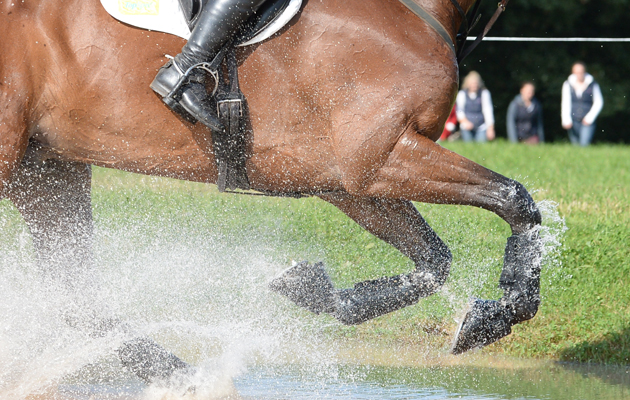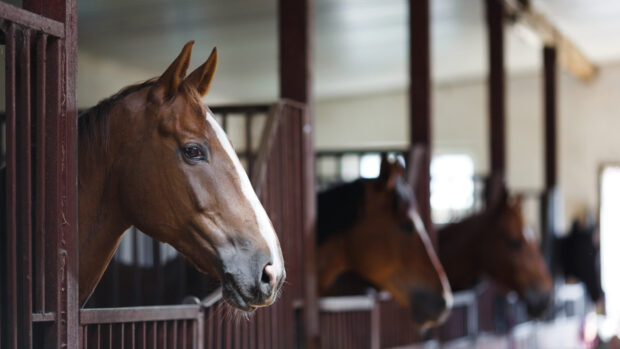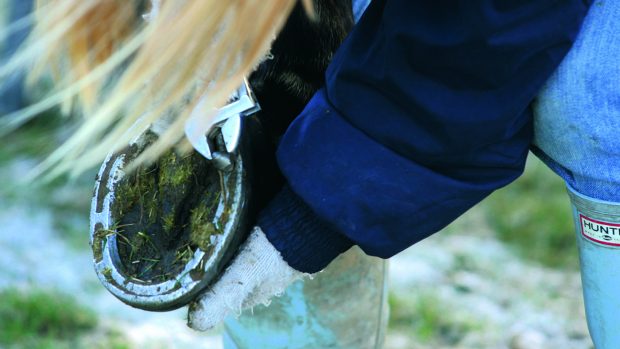Riders are often unsure when to use studs and how to select the right ones for their horse. H&H’s Pippa Roome seeks out some expert advice...
Are you fascinated by studs or do you see them as a necessary evil? It’s fair to say many riders are confused about when to use horse studs and may have been put off by some bad experiences along the way. Whether it’s spending frustrating hours trying to wheedle that tiny stone out of a stud hole, or sweating when the thread has twisted and the studs just won’t go in, if you use studs, it’s likely you’ve been there. So what is the best thing to do? And does your horses really need them?
When to use horse studs
Love them or loathe them, studs are as much a part of the competition scene as saddles and most riders competing on grass use them, especially if they are jumping. But should using studs be automatic or should we consider more carefully? How many studs is enough? And how big should they be?
“Don’t blame your studs,” says Holly Smith
Showjumper Holly Smith believes in understudding rather than overstudding and this is good advice, if in doubt. Holly thinks studs can make people ride recklessly.
“People ride as if studs are going to save them, but the most important factor when riding on grass is to keep horses’ confidence,” she says. “People spend too much time blaming their studs, rather than worrying about how they are riding.”
Holly’s husband, farrier Graham Smith, believes studs are “a necessary evil”. Like vet Richard Stephenson, he believes riders can be wrongly influenced into using too many studs by watching top competitors.
“Top horses are jumping bigger and turning tighter than your average horse,” he says. “People tend to put too many stud holes in, without regard for that and the fact the top boys are jumping on the best surfaces.”
While you might think a poor surface is a reason to use more studs, using too many on uneven footing can do more harm than good.
“It’s all about having the right size stud for the right conditions,” adds Graham. “Some horses are more sure-footed than others. We hunt our horses and school them round the farm, so they are used to working on different surfaces and balancing themselves.”
Don’t forget that in racing and out hunting, horses jump huge fences without studs. Granted, they may not take on the tight turns required in a jump-off or a cross-country combination, but jumping on grass does not have to go hand in hand with studding up.
How many studs should you use?
Having decided you are going to use studs, the next question is how many. Some riders are rumoured to use as many as six studs in each horseshoe. Top freelance groom Alex van Tuyll says she noted that the Swedes at the 2013 European Eventing Championships in Malmö generally had three studs per shoe across country.
“They went quicker and were more able to turn than the Brits,” she says. “But I would be nervous about doing that.”
The general consensus is that two per hoof is right in most circumstances.
Alex says: “If you compare it to people, if you snap a heel off and have no heel on one shoe, you have a really sore back before you get home. Why wouldn’t that be the same in horses?”
Holly concurs: “We always use two studs in all feet — especially on hard ground, you don’t want the horse to be uneven or twisting.”
Five-star event rider Nicky Roncoroni also favours two studs. But she would sometimes use only one on the outside of the shoe in the dressage, as she has found horses can knock themselves with an inside stud, particularly if they are young and unbalanced.
“Also, in young horse classes, you can’t use hind boots, so I would avoid studs on the inside of the hind shoes,” she says.
What sort of studs should you use?
Most riders and grooms use blunter studs inside and reserve those with points for the outside, because of the increased likelihood of injury if a horse catches itself with a sharp stud.
Richard Stephenson believes studs should be the same length on the inside and outside, even if you select different shapes.
Wetter, softer going generally demands bigger, squarer studs, while smaller, sharper ones are reserved for harder going.
However, event riders and grooms say that if the conditions get tough, big studs may be required.
“When I worked for William Fox-Pitt, we did use bigger studs than many people on cross-country day at three-days, but that was what the horses were used to,” says Alex.
“Once at Burghley when it was really wet, we bought extensions [a little block that screws into the stud hole and then has the stud screwed into it, making the stud larger].”
As a further example of this elite rider’s attention to detail, William’s horses had an extra stud hole on the outside of shoes for three-days, so they could still wear studs if something went wrong, such as a stud snapping off in the primary hole.
Nicky Roncoroni emphasises that horses have to retain the natural give in their stride — studs should not stop them in their tracks. But she has found she needs bigger studs now she rides faster and more competitively at the top level. At Pau in 2012, she took advice from experienced freelance groom Cara Bexton.
“I told Cara what studs I wanted and she said, ‘No, a lot bigger than that’,” recalls Nicky. “Until then I’d always erred on the side of caution. I also saw the studs the riders used at the 2012 Olympics and realised that bigger studs are necessary sometimes.”
Elodie Frost, former yard manager at eventer Gemma Stevens’ base, agrees.
“We use quite big studs most of the time, especially on the advanced horses who are going fast and over big fences — they need all the help they can get,” she says. “And as a groom, communicate with your rider — you might need to change studs halfway through the day.”
While ground is the driving force in choosing studs, Elodie and Alex say that horse type and movement are also a factor.
Alex adds: “A horse who is light on his feet will not need as much help as a heavier set one who gallops into the ground.”
Alex also says she would be particularly careful about stud choice, using smaller studs if a horse had glue-on shoes, which tend not to come off as easily as traditional nailed on ones.
The right decision for your horse
Studding is complicated and opinions vary on what is “right”. There are situations where it makes sense to consult more experienced riders or those who have already ridden the course.
But remember Richard Stephenson’s advice that you have to make your own decision about what is correct for your horse on the day.
- To stay up to date with all the breaking news from major shows throughout 2025, subscribe to the Horse & Hound website
You might also be interested in:

9 common cross-country queries solved
We ask the experts to tackle some common cross-country problems, from dealing with green horses to keeping your horse focused

Lucinda Green: how to become a good cross-country rider
Do you know how to train your horse to safely get to the other side of every fence? According to

Subscribe to Horse & Hound magazine today – and enjoy unlimited website access all year round




